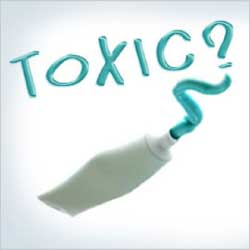 Most parents are careful about learning what’s in the stuff their kids eat and drink. They avoid artificial dyes, preservatives, chemicals, and sweeteners. Yet ask just about any of those same folks if they have ever looked at what is in their toothpaste and you’ll likely get blank stares. Considering the fact that children – and adults -- ingest toothpaste twice a day every day, it’s probably the most frequent thing we put in our mouths other than water or other beverages. And still, most people have never looked at what is in their toothpaste.
Most parents are careful about learning what’s in the stuff their kids eat and drink. They avoid artificial dyes, preservatives, chemicals, and sweeteners. Yet ask just about any of those same folks if they have ever looked at what is in their toothpaste and you’ll likely get blank stares. Considering the fact that children – and adults -- ingest toothpaste twice a day every day, it’s probably the most frequent thing we put in our mouths other than water or other beverages. And still, most people have never looked at what is in their toothpaste.
Dentist and national oral health care expert Harold Katz, (www.therabreath.com), suggests that needs to change. Many ingredients in some commercial toothpastes are of questionable benefit and some are just plain bad for you. Consumers have become increasingly aware of the hidden toxins in foods, beverages and eating and drinking utensils, he says. They avoid high fat and high sodium foods, sulfates in their personal care products, aerosol sprays, and toxic chemicals in their household cleaners.
“They’re taking no chances, and rightfully so. Remember the rush to replace plastic baby bottles with glass ones after the BPA scare in 2008?” he asked. However there has been a surprising lack of attention to toothpaste, Katz says. The dentist suggests that all consumers – but especially parents – take the time to read their toothpaste tubes today. Effects of potentially unhealthy toothpaste ingredients are multiplied in the smaller bodies of children.
Here are a few ingredients to stay away from:
- FD&C blue dye No. 2: This commonly used toothpaste dye is one of several on the list of additives to avoid, maintained by the Center for Science in the Public Interest. It’s said to be linked to learning, behavioral and health problems, severe allergic reactions, and headaches, among other problems.
- Sodium lauryl sulfate: The American College of Toxicology reports this ingredient in cosmetics and industrial cleaning agents can cause skin corrosion and irritation. Doses of .8 to 110 grams/kilogram in lab rats caused depression, labored breathing, diarrhea and death in 4 out of 20 animals.
- Triclosan: An anti-microbial ingredient, the federal Environmental Protection Agency lists triclosan as a pesticide and regulates its use in over-the-counter toothpastes and hand soaps. According to the agency’s fact sheet, "Studies on the thyroid and estrogen effects led EPA to determine that more research on the potential health consequences of endocrine effects of triclosan is warranted. … Because of the amount of research being planned and currently in progress, it will undertake another comprehensive review of triclosan beginning in 2013."
- Saccharin and aspartame: Both of these artificial sweeteners are on the Center for Science in the Public Interest’s list of additives to avoid.
Toothpaste buyers should look for natural ingredients, such as aloe vera juice, which cleans and soothes teeth and gums and helps fight cavities, according to the May/June 2009 issue of General Dentistry, the Academy of General Dentistry's clinical, peer-reviewed journal. Aloe vera tooth gel is said to kill disease-causing bacteria in the mouth, Katz says.
Also, avoid all toothpastes that contain sodium lauryl sulfate, a harsh detergent that has been linked to canker sores. Toothpastes that are free of sulfates include Weleda’s Salt Toothpaste, TheraBreath and Tom’s of Maine. Brush your teeth at least twice a day and get children into the habit from a young age, Katz says. You’ll have fresh breath, avoid painful dental problems, and be far more likely to have your teeth in your mouth when you go to sleep at night as you age.
Just be sure to check what’s in your family’s toothpaste and avoid buying anything with problematic ingredients. And when it comes to brushing kids teeth use a pea-sized drop of paste on the brush – no more – and oversee brushing to ensure young children don’t swallow their toothpaste, says Dr Katz.
I'm a former 7th grade Science teacher turned stay-at-home mom that lives in Houston, Texas. I am married to my college sweetheart and have a beautiful daughter named Riley, who definitely keeps me on my toes! I am also involved in starting a small business which would both manufacture and sell an invention that I've patented, called Toothpaste 2 Go. I love interacting with my readers and hope to learn as much about you as you learn about me!
Melissa @ Mommy Living the Life of Riley!
Add Melissa Cleaver to your LinkedIn Network
Add Mommy Living the Life of Riley to your Google+ circle |









